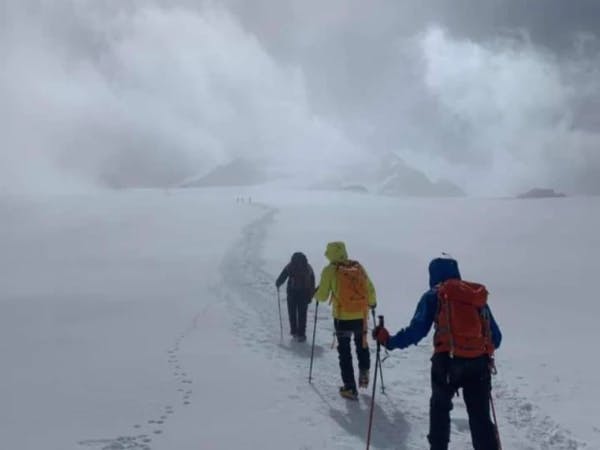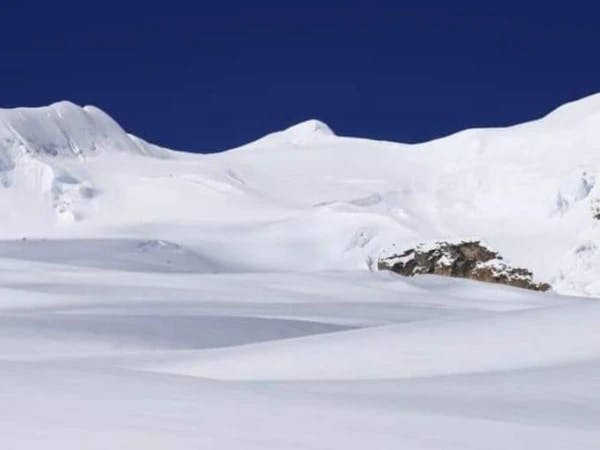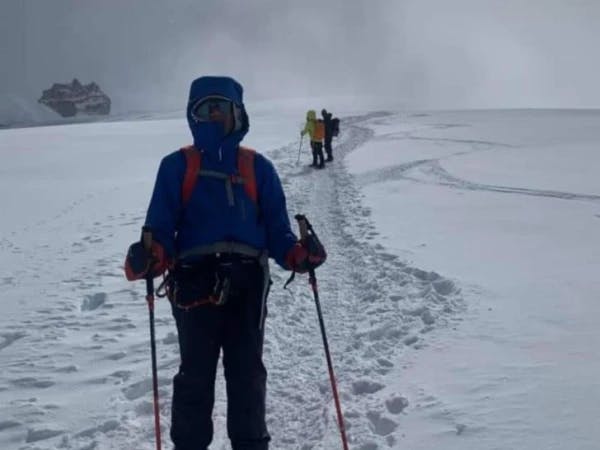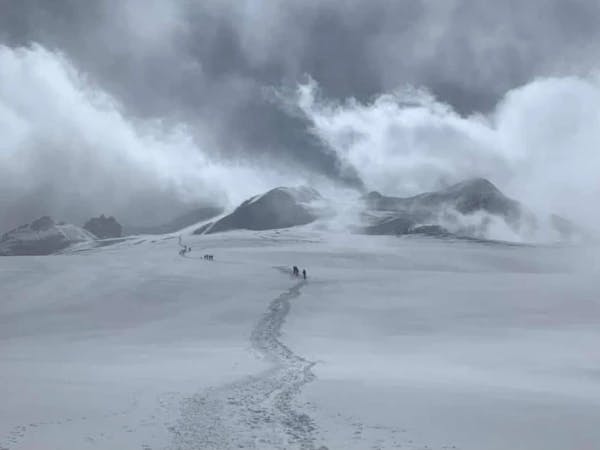Mera Peak Climbing is one of the most iconic and pleasurable Himalayan expeditions that takes you to the summit, renowned as the highest trekking peak in the country of hills and mountains, Nepal. Situated at an elevation of 6,476m in the Khumbu/Everest region of the country in an area encompassed by the top of the world, Mt. Everest (8,848m) features the raw wilderness that might have vanished from some of the other trekking routes in the region, such as the Everest Base Camp Trek, the Gokyo Cho La Pass Expedition, and others, due to recent years of massive tourists heading towards it.
As one of the less-frequented trekking trails in the Everest region precisely popular for climbing, the journey to Mera Peak is an adventurous experience that passes by several Sherpa dwellings, granting you an authentic mountain life, culture, traditions, and the genuinely warm hospitality of the locals rooted deeply in nature and mountains, treasuring it as god and goddess, which keeps you motivated and inspired throughout this epic voyage as you make your way along the Hinku and Hunku river valleys protected within the Makalu Barun National Park.
Further, located in isolation, the odyssey to Mera Peak offers you the true serenity of moving forth through lush forest, cascading waterfalls, and roaring rivers, viewing some of the spectacular glaciers and snow-capped peaks such as Mt. Everest (8,848 m/29,029 ft), Lhotse (8,576 m/27,940 ft), Makalu (8,485 m/27,838 ft), Cho Oyu (8,118 m/26,864 ft), Kanchenjunga (8,586 m/28,169 ft), and several others, creating varied yet scenically awe-inspiring landscapes.
Therefore, the climbing expedition to Mera Peak is a surreal and rewarding adventure offering out-of-the-world views and a taste of true Himalayan mountaineering without much of a technical difficulty as compared to some other extremely high-altitude summit climbing, embodying just the perfect ambiance for those seeking to unwind themselves in the beauty and grandeur of the Nepalese Himalayas required to be called the adventure of a lifetime. Ammonite Adventure and Treks is offering the best itinerary with flexible budget planning for the years 2024 and 2025.
Highlights
- Venture into one of the best off-beaten adventurous routes within the Everest Trekking region.
- Explore the secluded area of the Nepalese Himalayas, gaining unique perceptions of some of the top-notch eight-thousanders of the world, including Mt. Everest, Makalu, Cho Oyu, Kanchenjunga, Lhotse, and others.
- Ideal climbing destination throughout the year in Nepal for beginners to pro-level climbers.
- Discover the rich cultural tapestry of the Hinku and Hunku river valleys of the Khumbu region.
- Breathe in the pristine air of the alpine highlands and experience the first-hand hospitality of the legendary Sherpa people, etc.
What to expect during the voyage to climb Mera Peak?
Mera Peak climbing is a thrilling and challenging adventure offering an extraordinary blend of cultural immersion, natural beauty, mountaineering achievement, panoramic vistas, and an unparalleled opportunity to soak yourself in the mythical beauty of the Himalayas like never before for an amazing transformative journey.
As scenic as it is and a visual feast, it is also conquering, requiring strong willpower and a good amount of physical fitness. Being prepared properly during the climbing expedition to Mera Peak is very fulfilling and here’s what you can expect to create everlasting memories:
The thrilling flight to the smallest airport in Nepal, Lukla from Kathmandu
Like any other classic Himalayan excursion in Nepal, such as the Annapurna Circuit Trek in the Annapurna region or the Gokyo Cho La Pass expedition within the Everest region, the jaunting to the Mera Peak to achieve the top of it also begins with a scenic flight to Nepal’s smallest airport in Lukla, named Tenzing-Hillary Airport, which serves as the gateway to the region.
The flight departing from the Tribhuvan International Airport in the hustling and bustling city of Kathmandu provides trekkers, climbers, and adventurers alike with mesmerizing aerial views of the Himalayas right from takeoff-catching glances into some of the iconic mountains not only nationally but also internationally, like Everest, Lhotse, and Nuptse.
Lying at an altitude of 2,845 m (9,334 ft) above sea level, Lukla Airport’s runway is perched on a steep hill and is comparatively short, demanding skilled pilots for successful navigation. Flying over it marks the beginning of the journey to the Everest region and its surroundings, including the Mera Peak climbing voyage, which stands out as one of the most challenging and exhilarating landings in the world amidst the dramatic landscapes surrounded by a series of snow-covered peaks.
Making way through the lovely Sherpa settlements of the Everest region
Characterized by unique Tibtean-style houses with wooden cravings and painted window frames, making way past these Sherpa villages is one of the major highlights of the Mera Peak climbing in the Everest region, offering adventurous spirits the ultimate opportunity to immerse themselves in the enriching lifestyle of the widely celebrated Sherpa people for their notable adaptation capacity to the grueling mountainous surroundings at a high altitude.
Walking through these tiny yet picturesque dwellings, usually with stone-paved alleyways, on the way to Mera Peak Climb provides you with the timeless satisfaction of observing architecture blending in perfect harmony with the natural surroundings as you make your way past numerous colorful prayer flags and traditional Buddhist monasteries with continuous encounters of friendly locals to interact with them and gain significant knowledge on their simple yet holistic customary life, festivals and ceremonies, and further delve into their local delicacies.
From Lukla, trekkers, climbers, and travelers alike get to unwind through these several Sherpa villages heading to Mera Peak, be it for a trek, a small visit, a summit climb, or with any other purpose, traversing along the landscapes transitioning from verdant valleys to alpine meadows, rocky moraines, and adventurous suspension bridges manifesting breathtaking scenery.
Magnificent view from Mera Peak
Upon reaching the summit of Mera Peak, climbers are granted the most heavenly sight of the surrounding peaks, such as Everest, Lhotse, Makalu, Kanchenjunga, Barubtse, Ama Dablam, and numerous other Himalayan peaks dominating each direction that have been following them since the starting point of the journey to Mera Peak, Lukla, along with an immeasurable sense of accomplishment.
In addition to some of these major peaks from the Everest region stretching to the horizons, which are nothing short of mind-blowing, climbers can relish several glacial valleys, rugged ridges, and lush forests from Mera Peak to wonder at the world’s most dazzling natural beauty, which will definitely be a humbling and unforgettable experience in the center of the Himalayas.
Remarkable varied landscapes and terrain of the Everest Region
The Mera Peak climbing journey venturing deep into the Makalu Barun National Park area showcases the sensational beauty and diversity of both the Everest region and the Makalu Barnu National Park area as you move from lush lowland, valleys, forests, alpine meadows, and pastures to glacial moraines, ice fields, and snow-clad peaks on high-altitude passes, plateaus, glacier crossings, and icefalls.
Usually, the arid section of the Mera Peak Climbing Expedition begins at High Camp, unveiling the secluded rugged grandeur of the Himalayas and offering trekkers and climbers a chance to reflect on themselves amidst the incomparable natural beauty of the Everest region and Makalu Barun National Park.
Spring specifically creates a contrasting beauty of the lower region to the Upper Himalayas of Mera Peak due to the vibrantly blooming wildflowers below Mera Peak, while the mountain range and its closer section are usually covered with snow, and hence the climbing journey to Mera Peak in the Everest region is going to be the most unforgettable adventure.
Demanding yet gratifying climb to Mera Climb
Nothing can beat the adventure of rambling to the Mera Peak, testing climbers in each way possible, be it physically, mentally, or emotionally, as you ascend to the greater height, jaunting through steep snow slopes, mountain passes, rocky ridges, and terrain, possible encounters of crevasses from High, along with weather warmth as a core element of an adventurous journey.
Situated in a remote and rugged wilderness area, miles away from modern amenities and infrastructure, standing atop the Mera Peak summit in the heart of the Himalayas is truly a moment of triumph and fulfillment, making the entire odyssey worthwhile despite the journey challenging one’s perseverance, courage, and determination each step along with the potential occurrence of acute mountain sickness (AMS) or altitude sickness, adding much to the excitement of having successfully achieved the adventure that comes once in a life.
The 16-day itinerary and route for Mera Peak Climbing
Your Mera Peak Climbing journey to the Everest region begins with an early morning adrenaline-rushing flight from Kathmandu to Lukla after a night in the capital city of Nepal, Kathmandu, which is home to at least seven of the world’s UNESCO Heritage Sites, where you can take yourself in guided strolling on being transferred to your hotel by Ammonite Adventure and Treks Pvt. Ltd.
By the second day, you would have already made it to the Everest/Khumbu trekking region of Nepal to spend your very first trek night at the local mountain lodge of Paiya, from where you will simultaneously make your way through verdant hills and picturesque Sherpa villages in an order of Pangom, Ningsow, Chhatra Khola, Kothe, Thaknak, and Khare, crossing several suspension bridges and viewing some of the top-notch peaks, prayer flags, Mani walls, and monasteries.
Arrival at Khare based on the 16-day itinerary marks the acclimatization day so your body can function well on upcoming higher alpine rambling, and hence, on a spare day, you will engage yourself in some pre-climbing activities under the guidance of your mountain guide, who will also provide you with more sorted-out instructions on the use of climbing gear and equipment.
Nonetheless, this 16-day Mera Peak climbing route takes you to high camp after a pleasing stay out at Khare, from where you will head to the top of Mera Peak on the following day and get back to Khare for the third night on the most-awaited dream-come adventure of successful ascent to Mera Peak Summit. Much to the delight of adventurers, the 16-day itinerary to climb Mera Peak has allocated a reserve day for contingency as well that you can use to attempt the climb for the second time if you were not favored by the weather the previous day, and therefore the 16-day itinerary and route to climb Mera Peak is considered the best one amongst the different choices and trails you will be presented.
On conquering Mera Peak and getting back to Khare, the journey to return to Kathamandu begins, which descends gradually from Kothe, Thuli Kharka, and lastly Lukla via Zatrna La Pass to take a flight back to Kathamandu.
Mera Peak Climbing Cost
Although the total cost of Mera Peak Climbing can observe a notable variation based on numerous aspects such as the type of trekking or climbing operator you have chosen, itinerary, inclusion and exclusion, fees, regulation of permits at that precise time, and the number of climbers in the group, it can cost you anywhere from USD 2,800 to USD 5,000, where Ammonite Adventure and Treks Pvt. Ltd. is offering you a standard price of USD 2,257 per person.
Contact us now for a valued experience, personalized service, and a customized itinerary as per your needs and preferences.










